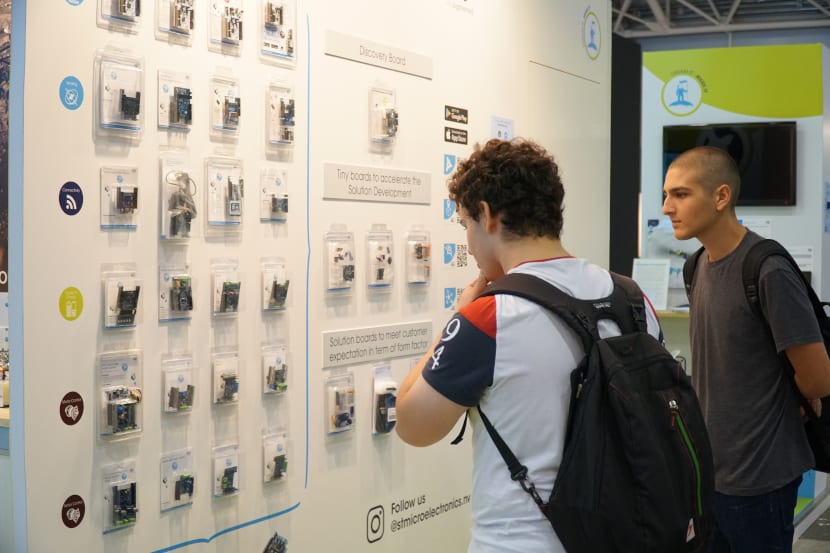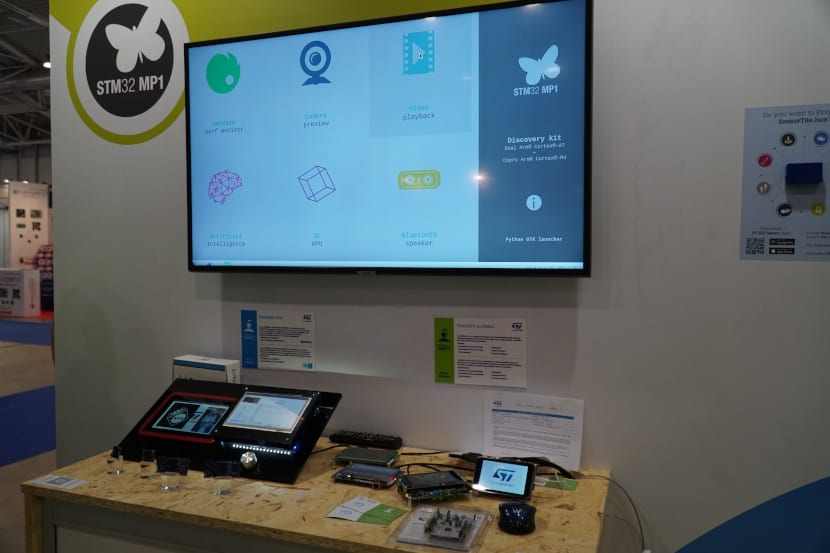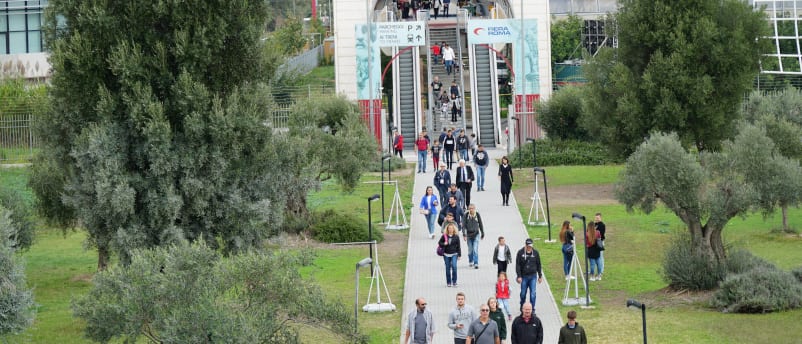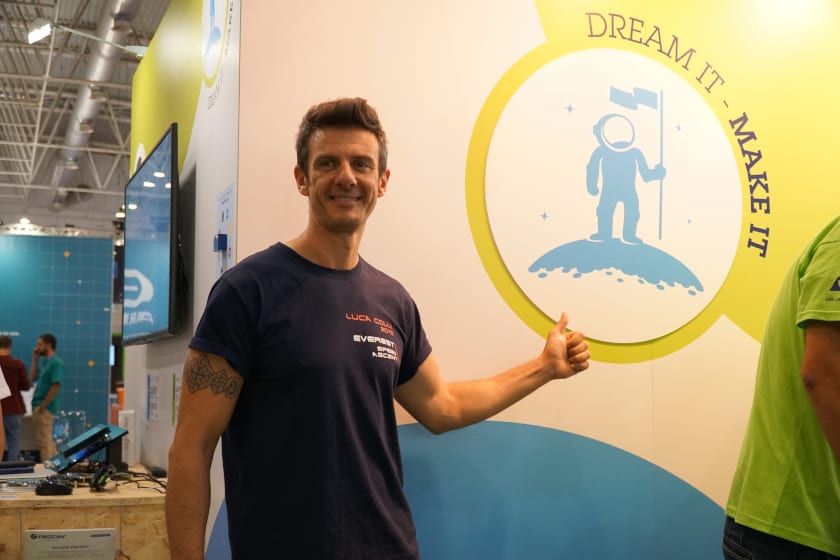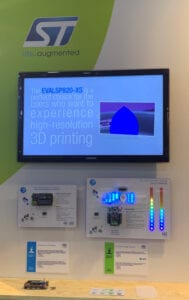Maker Faire Rome (Fiera di Roma) is a large fair for inventions and innovations, covering 50,000 ms2, that is opened to all forms of applied creativity, from serious and innovative ideas to more imaginative ones, from new technologies to traditional “know-how” and handicraft. It’s an event built to give space to creative, innovative, entertaining, interactive, and educational projects driven by passion and ingenuity.
For the fourth year, ST joined the Maker Faire in Rome as an exhibitor to showcase its latest technologies and what its partner universities and companies can do with them. For the first time, ST also took part in the opening ceremony, where we introduced the SensorTile.box to the attendees with the help of Luca Colli, the adventurer who recently climbed Everest. During his training and his ascension, he always kept two SensorTile.box to collect precise measurements such as movements, temperature, humidity, audio, pressure, etc. When Luca returned from the top of the world, we had the opportunity to sit down with him to talk about his adventure. You can read more about his experience in the interview we had with him.
Education to Make the World Better
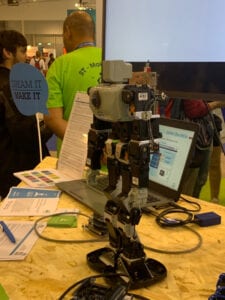 Futuristic and interesting was the Humanoid Robotics with STM32, developed with the students from the University of Catania (Italy). An Android app controls the robot by transmitting commands via Bluetooth Low Energy module of the BlueCoin platform collects. BlueCoin then sends them to a Nucleo board which translates them into movements. The BlueCoin is also used to identify the starting position of the Robot thanks to its integrated Accelerometer and Gyroscope (LSM6DSM).
Futuristic and interesting was the Humanoid Robotics with STM32, developed with the students from the University of Catania (Italy). An Android app controls the robot by transmitting commands via Bluetooth Low Energy module of the BlueCoin platform collects. BlueCoin then sends them to a Nucleo board which translates them into movements. The BlueCoin is also used to identify the starting position of the Robot thanks to its integrated Accelerometer and Gyroscope (LSM6DSM).
Students, with the help of ST, built two expansion board have been developed to connect the BlueCoin and the Nucleo:
- For the BlueCoin we have used an expansion that allows connecting UART and Power from the Nucleo.
- For the Nucleo board, we have developed an expansion allowing the connection of 6 UART, Power and Battery check
Education to Make the World Safer
The students of the University of Palermo (Italy) showed a smart helmet for the motorbike. The eCall system uses MEMS sensors (LIS2DW12 accelerometer) to determine when the cyclist or motorcyclist falls from their vehicle and, thanks to a specific Scaffa-Logger algorithm developed by the students, differentiate whether they just rolled over a pothole or really fell onto the street. A fall triggers an acoustic alarm that the user can disable by simply saying, “I’m fine, don’t call for help”. If the user does not reset the system within 30 seconds of the fall, it sends a distress signal over a LoRaWAN network thanks to a communications module based on STEVAL-STRKT01. The advantages of this network are many: it consumes very little, the single point-to-point connection has greater distances than the GSM / 4G / 5G network, and The LoRaWAN coverage should even penetrate remote areas in a few years.
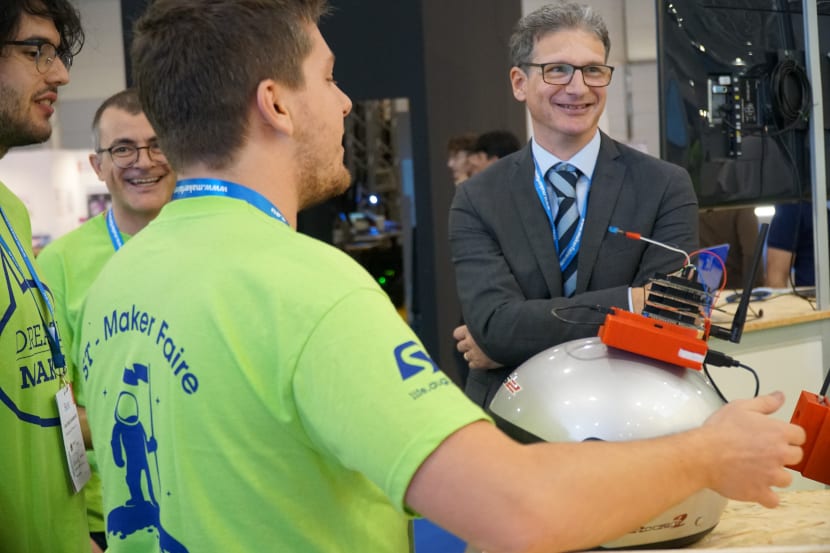
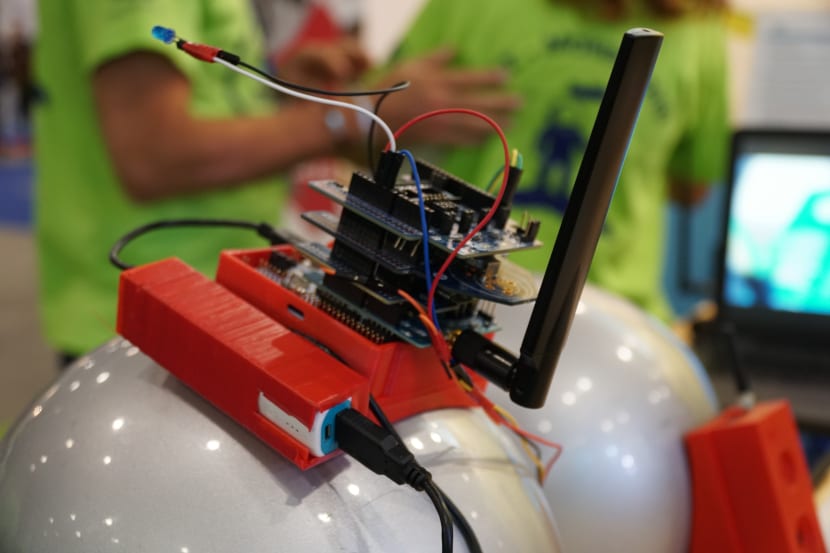
- ST products in the design: STM32L072CZ, LIS2DW12, Teseo-LIV3F, STBC02, …
Education to Make the World Greener
Students from universities in the Campania region (Italy) designed a hydroponic greenhouse that, thanks to the use of specific sensors, is able to understand environmental conditions. With this analysis, it becomes possible to find the right area to plant a specific crop. This would then make it easier to find the right conditions while making the process smarter as well as faster. This project was carried out within the Summer Campus of Neapolis Innovation (held in Naples from the end of August to September 8th). The system is based on Nucleo-F401RE (STM32F401RET) with VL6180X sensors to determine the ambient light and the HTS221 to determine humidity and temperature. The data is transferred to the Cloud through a Gateway for Cloud, so it can be viewed, and eventually, action can be taken to apply the corrective actions (not yet implemented). The project won the first prize at the Summer Campus held during the Neapolis Innovation and it is part of the IPCEI project. IPCEI on microelectronics is an Important Project of Common European Interest with the objective to provide leading European microelectronics technologies, chips, and systems as the base for a strong and independent application industry which is key for the digital future in Europe.
Education to Make Cities Smarter
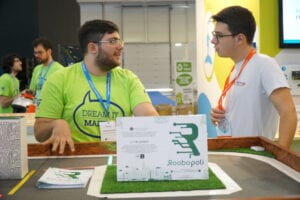 Roobopoli™ is a project that aims to create an educational experience for students from elementary to high school in the field of smart-cities, smart-industries, and smart grids. The project is from the non-profit association Perlatecnica, with the technical support of Bluenet. The mission of the project is to promote the understanding and the development of new communication technologies focused on mobility, environmental protection, energy efficiency, and automation technologies in the field of industry 4.0. The system is based on the STM32 ODE system with the NUCLEO-F401RE (based on STM32F401RET), the X-CORE-IHM12A1 (STSPIN240), X-NUCLEO-IKS01A2 (but we could write IKS01A3, the latest) and 53L0-SATEL- I1 (VL53L0).
Roobopoli™ is a project that aims to create an educational experience for students from elementary to high school in the field of smart-cities, smart-industries, and smart grids. The project is from the non-profit association Perlatecnica, with the technical support of Bluenet. The mission of the project is to promote the understanding and the development of new communication technologies focused on mobility, environmental protection, energy efficiency, and automation technologies in the field of industry 4.0. The system is based on the STM32 ODE system with the NUCLEO-F401RE (based on STM32F401RET), the X-CORE-IHM12A1 (STSPIN240), X-NUCLEO-IKS01A2 (but we could write IKS01A3, the latest) and 53L0-SATEL- I1 (VL53L0).
Education to Fly Higher
Inside the ST booth, there were also homemade demos. The most interesting and the ones that attract more audience at the event were the STM32MP1 and the STEVAL-DRONE01 (kit Drone), which features the high performance STEVAL-FCU001V1 flight controller unit, as well as the motors, propellers, plastic frame, and battery that will make a mini-drone. The flight controller unit runs the firmware (STSW-FCU001) to control the speed of each connected motor and to stabilize the drone. To achieve this, the STM32F4 microcontroller analyses data from the accelerometer and gyroscope sensors (LSM6DSL and iNEMO 6DoF) to provide highly accurate stability and control. The FCU board also includes a Bluetooth Low Energy SPBTLE-RF module, so users can turn their smartphone into a remote control. For those interested in building and flying their drone with ST’s first controller unit, we’ve created a community.
Building on the success of its STM32 microcontroller families, ST announced earlier this year its first microprocessor (MPU) series: the STM32MP1. These general-purpose multicore microprocessors will help facilitate the development of high-performance solutions across a broad range of application areas. The STM32MP1 offers a flexible architecture for applications, including home appliances, consumer and personal electronics, medical devices and industrial systems. ST is not targeting automotive applications with the STM32MP1, as the company has a dedicated automotive product group with specially designed and qualified automotive MCUs. Of particular interest to developers targeting long-lived industrial applications, the STM32MP1 carries with it a rolling 10-year longevity commitment that provides designers, product managers and procurement teams the assurance that components will remain available throughout the lifecycle of their design.
